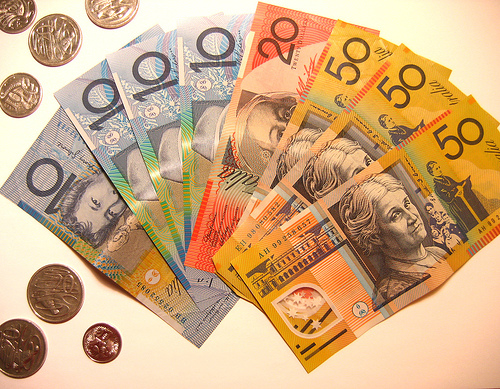 在最近的一次谈话中,澳大利亚央行(Reserve Bank of Australia)行长格伦·史蒂文斯(Glenn Stevens)提到了澳元在经济混乱时期所发挥的关键作用。他表示,如果中国经济出现严重滑坡,澳元可能会下跌,这将为澳大利亚国内经济带来亟需的提振。
在最近的一次谈话中,澳大利亚央行(Reserve Bank of Australia)行长格伦·史蒂文斯(Glenn Stevens)提到了澳元在经济混乱时期所发挥的关键作用。他表示,如果中国经济出现严重滑坡,澳元可能会下跌,这将为澳大利亚国内经济带来亟需的提振。
其中的道理显而易见。由于澳大利亚丰富的矿产资源和庞大的矿产行业,澳元被视为一种商品货币,也因而与中国经济增长状况密切相关。当中国经济放缓时,澳元下跌,澳大利亚贸易相关行业将从本币贬值中获得提振。
但史蒂文斯还提出了另一种假设:另一场金融危机——欧元区解体——可能会造成更多资金流入以澳元计价的资产。他表示:在这种情况下,我们的问题可能是无法吸纳这些资金。
尽管大宗商品(尤其是铁矿石和煤炭)价格急剧下跌,但澳元相对于其他主要货币的汇率却在上升。投资者在心目中认定澳元是一种避险货币。
受投资者担忧中国钢铁需求状况的影响,澳大利亚最重要的出口产品——铁矿石价格周二降至每吨115美元的两年半低位。与此同时,澳元汇率触及1澳元兑1.05美元水平,仅较2011年1.10美元的创纪录水平低5美分,较6月触及的8个月低点(1澳元兑0.969美元)有强劲回升。
澳元兑英镑和欧元汇率分别触及0.69英镑的6个月高点和创纪录的0.85欧元。3年前,当铁矿石价格位于每吨70美元水平时,澳元汇率为0.80美元上下。
分析师们为澳元令人意外的抗跌性提出了几种解释。首先,全球只有7个国家拥有AAA评级,澳大利亚是其中之一,三大评级机构对澳大利亚前景的评价都为稳定。
其次,截至今年3月的一年,澳大利亚国内生产总值(GDP)增长4.3%,这让该国成为全球表现最为强劲的发达经济体。失业率仍处于5.2%的低位,通胀率仅为1.2%。
第三,澳大利亚的利率仍相对较高,官方利率为3.5%。最后,人们预期其他大型经济体的央行将出台更多定量宽松政策,这种观点令澳元受益。
但摩根士丹利(Morgan Stanley)经济学家杰拉德·米纳克(Gerard Minack)表示,最重要的原因是避险买盘。他表示:我们提供的是一种越来越稀有的商品,那就是AAA评级的政府债券,锦上添花的是,它们在最高评级债券中拥有最高的收益率。
澳大利亚10年期政府债券收益率为3.05%,而美国和英国均为1.48%。
澳元正吸引来自央行和主权财富基金的买盘,这些机构正推行外汇储备多元化,降低美元、日元、尤其是欧元等传统储备货币的比重。
从美元转向其他货币的多元化现象已出现了多年时间,位于悉尼的澳新银行(ANZ)首席经济学家沃伦·霍根(Warren Hogan)表示,我认为,过去6个月流向澳大利亚的资金更多的是私人和公共投资者从欧洲资产转向其他资产。
交易员表示,过去一个月,德国、瑞士、哈萨克斯坦、捷克和越南央行要么已买入澳元,要么正考虑将澳元加入其外汇储备投资组合中。
实际上,根据当地媒体的报道,因积累巨额外汇储备获得新的中国(new China)称号的瑞士9个月前就开始买入澳元,并设立了一个银行交易委员会,负责监督买入政府债券等澳元计价资产。
6年前,与我们商谈的央行通常不到9家,澳大利亚联邦银行(Commonwealth Bank of Australia)首席外汇策略师理查德·格雷斯(Richard Grace)表示,如今,与我们商谈的央行超过了50家,我们知道,它们正将澳元加入其外汇储备。
在2350亿澳元的澳大利亚联邦政府证券市场上,境外投资者占据着主导地位。根据澳大利亚金融管理办公室(Australian Office of Financial Management)的数据,今年3月底,非居民投资者持有的联邦政府证券比例达到创纪录的76.5%。
格雷斯认为,这一比例接近饱和点,但随着海外投资者涌入其他澳元计价资产,如州政府债券和地区政府债券、企业债券以及银行票据,资金流入并未显示出放缓迹象。格雷斯表示:我们在这里看到大规模的投资。
鉴于澳元实现自由浮动后的平均汇率为0.75美元,对于投资者而言,关键问题是:面对大宗商品价格的不断下跌,上述这些因素能够在多长时间内继续支撑处于高位的澳元汇率?
In a recent talk, Glenn Stevens, Reserve Bank of Australia governor, touched on the key role the Australian dollar plays in times of strife. He said if there were a serious decline in China, the Australian currency would “probably” fall, providing a much-needed boost to the domestic economy.
The logic was obvious. Because of Australia’s vast mineral wealth and large mining industry, the “Aussie” is regarded as a commodity currency and, by extension, closely correlated to Chinese growth. As China slows, the Aussie falls and trade-exposed sectors get a boost from a lower exchange rate.
But Mr Stevens also outlined an alternative scenario in which another financial crisis – a break-up of the eurozone – might result in a larger flow of funds into Aussie-denominated assets. “In that case, our problem might be not being able to absorb that capital,” he said.
That scenario of the Aussie as a haven is in investors’ minds as it grinds higher against big peers despite a sharp fall in prices of commodities, particularly iron ore and coal.
As prices for iron ore, Australia’s biggest export, sank to a two and a half year low of $115 a tonne on Tuesday, driven by concerns about Chinese steel demand, the Aussie hit US$1.05, just 5 cents shy of its 2011 record of US$1.10 and a strong rebound from June’s eight-month low of US$0.969.
It has touched a six-month high of £0.69 against sterling and a record €0.85 against the euro. To put those figures into perspective, when iron ore was trading at $70 a tonne three years ago, the Aussie was about US$0.80.
Analysts posit several explanations for the unexpected resilience of the Aussie. First, Australia is one of only seven countries to have a triple A rating, with a stable outlook from all three main agencies.
Second, gross domestic product grew 4.3 per cent in the year to March, making Australia the world’s strongest-performing developed economy. Unemployment remains low at 5.2 per cent, while inflation is only 1.2 per cent.
Third, Australia still has relatively high interest rates, with the official cash rate at 3.5 per cent. Finally, the Aussie is benefiting from expectations of more “quantitative easing” by other big central banks.
But the most important reason is haven buying, says Morgan Stanley economist Gerard Minack. “We offer what is an increasingly rare commodity, which is a triple A rated government bond with the icing on top the highest yield on those top-rated bonds,” he said.
The 10-year Australian government bond yields 3.05 per cent versus US and British counterparts, each yielding 1.48 per cent.
The Aussie is drawing demand from central banks and sovereign wealth funds shifting from traditional reserve currencies such as the US dollar, the yen and particularly the euro.
“Diversifying away from US dollars has been a phenomenon that has been around for several years,” says Warren Hogan, chief economist at ANZ in Sydney. “I get a sense that these flows into Australia in the last six months have been more about diversifying away from Europe by both private and public investors.”
In the past month, say traders, the central banks of Germany, Switzerland, Kazakhstan, the Czech Republic and Vietnam have either bought or are considering adding the Aussie to their foreign exchange reserve portfolios.
In fact, Switzerland, which has been dubbed the “new China” because of the huge forex reserves it has amassed, started buying the Aussie nine months ago, according to local media reports and has established a trading panel of banks to oversee buying of Aussie-denominated assets such as government bonds.
“Six years ago we used to talk to less than nine central banks,” says Richard Grace, chief currency strategist at Commonwealth Bank of Australia. “Today we speak to more than 50 and we know they are adding the Aussie to their reserves.”
Offshore investors dominate Australia’s A$235bn Commonwealth Government Securities market. At the end of March non-resident investor holdings of CGS reached a record 76.5 per cent, according to the Australian Office of Financial Management.
That share is close to saturation point, reckons Mr Grace, but the inflows show no sign of slowing as overseas investors pour into other Aussie-denominated assets such as state and territory government debt, corporate bonds and bank bills. “We are seeing large investment here,” says Mr Grace.
Given the Aussie’s post-float average of US$0.75, the key question for investors is how long these factors will continue to support the Australian currency at an elevated level in the face of falling commodity prices.
 在最近的一次谈话中,澳大利亚央行(Reserve Bank of Australia)行长格伦·史蒂文斯(Glenn Stevens)提到了澳元在经济混乱时期所发挥的关键作用。他表示,如果中国经济出现严重滑坡,澳元可能会下跌,这将为澳大利亚国内经济带来亟需的提振。
在最近的一次谈话中,澳大利亚央行(Reserve Bank of Australia)行长格伦·史蒂文斯(Glenn Stevens)提到了澳元在经济混乱时期所发挥的关键作用。他表示,如果中国经济出现严重滑坡,澳元可能会下跌,这将为澳大利亚国内经济带来亟需的提振。
